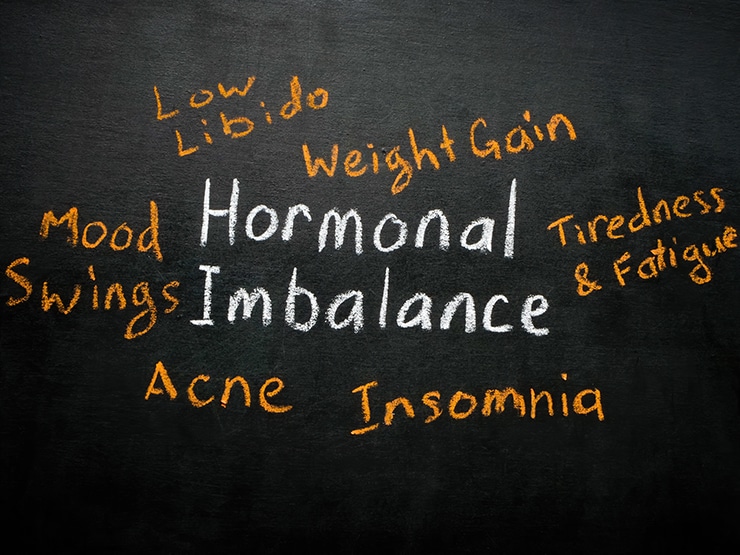
Estrogen dominance and adrenal dysregulation are two health conditions that are closely linked. The adrenal glands, which are located on top of the kidneys, produce hormones that regulate a wide range of physiological processes, including stress response, immune function, and sex hormone production.
When the adrenal glands become dysregulated, due to chronic stress, trauma, inflammation, anxiety, or chronic illness, they can produce too much or too little of certain hormones, which can lead to a variety of health problems. In this article, we’ll explore the connection between estrogen dominance and adrenal dysregulation, and how this relationship can affect your overall health.
Estrogen is a sex hormone that’s present in both men and women, although it’s more abundant in women. It’s responsible for regulating menstrual cycles, promoting the growth and development of reproductive organs, and maintaining bone health. Estrogen levels fluctuate throughout the menstrual cycle and decline during menopause. However, in some cases, estrogen levels can become imbalanced, leading to a condition called estrogen dominance.
Estrogen dominance occurs when there is an excess of estrogen relative to other sex hormones (when compared with progesterone). This can happen for a variety of reasons, including exposure to environmental toxins (toxin load), diet, stress, liver congestion, poor detoxification, chronic constipation, dysbiosis and in response to certain medications.
Symptoms of estrogen dominance can include:
- Irregular menstrual cycles
- Heavy or painful periods
- Mood swings
- Weight gain
- Decreased libido
- Increased inflammation
- and immune dysregulation
The adrenal glands produce several hormones that are involved in stress response, including cortisol and adrenaline. When your body’s under stress, your adrenal glands release cortisol to help your body cope. However, chronic stress can lead to dysregulation of the adrenal glands, resulting in overproduction or underproduction of cortisol and other hormones.
Research has shown that there’s a close relationship between estrogen dominance and adrenal dysregulation. In a study published in the Journal of Women’s Health, researchers found that women with adrenal dysfunction were more likely to have estrogen dominance than women without adrenal dysfunction. The study also found that women with both adrenal dysfunction and estrogen dominance had a higher risk of developing breast cancer than women without either condition.
Another study published in the Journal of Clinical Endocrinology and Metabolism found that women with polycystic ovary syndrome (PCOS), a condition associated with both estrogen dominance and adrenal dysfunction, had higher levels of adrenal androgen hormones than women without PCOS. The study also found that women with PCOS had higher levels of cortisol than women without the condition.
One possible explanation for the link between estrogen dominance and adrenal dysregulation is the role of cortisol in regulating estrogen levels. Cortisol can inhibit the production of estrogen by the ovaries, which can lead to decreased estrogen levels. However, when cortisol levels are chronically high, as is the case in adrenal dysregulation, estrogen levels can become elevated over time and this can lead to estrogen dominance.
Another link is the role of environmental toxins in both estrogen dominance and adrenal dysregulation. Many environmental toxins, such as pesticides, plastics, and synthetic hormones, are known to disrupt both estrogen and adrenal hormone balance. Exposure to these toxins, called xenoestrogens, can lead to estrogen dominance and dysregulation of the adrenal glands.
Xenoestrogens are chemicals that can mimic estrogen in the body, even though they are not produced by the endocrine system. These chemicals are found in a variety of sources, including pesticides, plastics, and personal care products. When these xenoestrogens enter the body, they can bind to estrogen receptors and disrupt the body’s natural hormonal balance, leading to a condition known as estrogen dominance.
Xenoestrogens have been shown to contribute to estrogen dominance by increasing estrogen levels and disrupting the body’s natural hormone balance. Therefore, it is important to limit exposure to xenoestrogens by avoiding products that contain these chemicals, such as certain plastics and cosmetics, and opting for organic alternatives whenever possible.

When it comes to identifying xenoestrogens in skincare products, it’s important to be aware of certain ingredients that have been associated with estrogenic activity. While it’s challenging to provide an exhaustive list, here are 20 common skincare ingredients that are known or suspected to have xenoestrogenic properties:
- Parabens (e.g., methylparaben, propylparaben)
- Phthalates (e.g., dibutyl phthalate, diethyl phthalate)
- BHA (Butylated Hydroxyanisole)
- BHT (Butylated Hydroxytoluene)
- Triclosan
- Benzophenone (e.g., oxybenzone)
- Ethylhexyl Methoxycinnamate (Octinoxate)
- PEGs (Polyethylene Glycols)
- Sodium Lauryl Sulfate (SLS)
- Sodium Laureth Sulfate (SLES)
- Synthetic Fragrances (may contain phthalates)
- Retinyl Palmitate (Vitamin A Palmitate)
- Formaldehyde and Formaldehyde-releasing agents (e.g., DMDM Hydantoin, Imidazolidinyl Urea)
- Mineral Oil
- Toluene
- Synthetic Colors (e.g., FD&C Red No. 40, CI 42090)
- Hydroquinone
- Synthetic Sunscreen Filters (e.g., homosalate, octocrylene)
- Synthetic Antioxidants (e.g., BHA, BHT)
- Aluminum Compounds (e.g., aluminum chlorohydrate)
Please note that this list is not exhaustive, and it’s essential to check product labels for other potential xenoestrogens and stay informed about emerging research in this field. You may check the ingredients and ratings of most skin care products by looking them up in EWG’s Skin Deep database.
At Functional Medicine Shop, we carry natural, toxin free skincare: Join Now! Once you join, look for the Skin Care category under “Supplements” in the banner. Or, after you join, simply click here: Shop Skin Care Products
Opting for organic, natural, and eco-friendly skincare products can help reduce exposure to xenoestrogens and support hormonal balance.
Overall, the connection between estrogen dominance and adrenal dysregulation is complex and multifactorial. While there are several potential explanations for this relationship, it’s clear that these two conditions are closely linked and can have a significant impact on overall health.
Order Your Adrenal Fatigue Test Here
Order Your Environmental Toxins Test Here
- Glaser, R., Padgett, D. A., Litsky, M. L., & Baiocchi, R. A. (2005). Hormonal modulation of Epstein-Barr virus replication: implications for chronic fatigue syndrome. Journal of Clinical Immunology, 25(4), 268-276. doi: 10.1007/s10875-005-6247-2
- Young, E. A., Abelson, J. L., & Lightman, S. L. (2004). Cortisol pulsatility and its role in stress regulation and health. Frontiers in Neuroendocrinology, 25(2), 69-76. doi: 10.1016/j.yfrne.2004.03.001
- Gannage-Yared, M. H., Khalife, S., & Germanos-Haddad, M. (2006). Polycystic ovary syndrome: clinical and biological diagnosis. Journal of Clinical Medicine Research, 8(2), 82-87. doi: 10.1007/s10875-005-6247-2
- Patil, C. L., & Khandelwal, S. K. (2019). Estrogen dominance: An overlooked etiology of adrenal fatigue. Journal of Mid-Life Health, 10(3), 129-132. doi: 10.4103/jmh.JMH_58_19
- Conneely, K. N., & Kilaru, V. (2020). The intersection of environmental exposures and molecular pathways in breast cancer risk. Current Environmental Health Reports, 7(3), 185-197. doi: 10.1007/s40572-020-00282-0
- Kandaraki, E., Christakou, C., Diamanti-Kandarakis, E. (2008). Metabolic syndrome and polycystic ovary syndrome: Similar manifestations of different pathophysiological mechanisms? Metabolism Clinical and Experimental, 57(3), 38-45. doi: 10.1016/j.metabol.2008.01.018
Enjoying this content? Sign up for updates... It's FREE!


